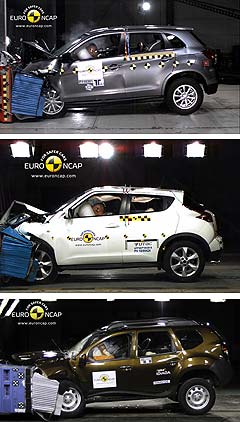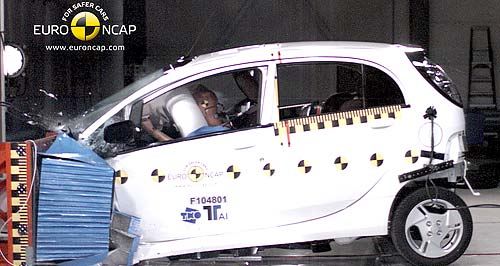Make / Model Search
News - General News - SafetyMitsubishi’s i-MiEV grabs four starsNo sparks: The Mitsubishi i-MiEV’s electrical safety systems all performed to specification in Euro NCAP crash tests. First EV crash test fails to short-circuit electric Mitsubishi i-MiEV in Euro NCAP24 Feb 2011 THE first full-electric car tested under a New Car Assessment Program (NCAP) safety regime anywhere in the world, the Mitsubishi i-MiEV, scored four stars in the latest round of European results announced today. Crash test technicians took extra safety precautions for the test, due to the danger of electrocution from the i-MiEV’s battery-powered drive train, but no electrical or fire hazards surfaced in post-crash checks. New test procedures were also developed to test battery integrity and the performance of the battery cut-off switch that is designed to isolate the high-voltage battery on impact. Euro NCAP described the four-star result as creditable, even though driver’s chest protection was rated as marginal and points were deducted for passenger compartment distortion. Euro NCAP secretary general Dr Michiel van Ratingen said his organisation recognised Mitsubishi’s efforts to demonstrate that plug-in battery powered cars could be as safe as others. “It shows that a future five-star accolade for EVs is not unthinkable,” he said.  Left: The Mitsubishi ASX (top) and Nissan Juke (middle) both scored the maximum 5-star rating, while the Dacia Duster (bottom) scored a lowly 3-stars. Left: The Mitsubishi ASX (top) and Nissan Juke (middle) both scored the maximum 5-star rating, while the Dacia Duster (bottom) scored a lowly 3-stars.“Whether produced by established car manufacturers or by new players on the market, consumers should expect to get electric vehicles that meet the same safety standards as conventional vehicles.” The diminutive i-MiEV’s adult protection was rated at 73 per cent, which compares with the 86 per cent rating for Mitsubishi’s ASX compact SUV that scored five stars in the same round of tests. The electric car’s child protection capability was rated at 78 per cent – the same as that of the ASX – but its pedestrian protection result was just 48 per cent, compared with the bigger vehicle’s 60 per cent. The i-MiEV’s test results are also applied to the Citroen C-Zero and Peugeot iOn, which are re-badged i-MiEVs made to the same safety standard. Like most other NCAP tests done in Europe for cars sold globally, the i-MiEV and ASX results are likely to be adopted by Australian NCAP, as long as the Australian team finds no substantial safety differences in the local-specification vehicles. Other five-star results went to Nissan’s small crossover vehicle, the Juke, which scored an excellent 87 per cent in adult protection, 81 per cent in child safety, but a lowly 41 per cent in pedestrian impact protection. Last October, Nissan Australia indicated it was considering Juke for Australia, a move that will not be harmed by the five-star overall rating. The related Dacia Duster – built on Nissan’s B0 platform – is unlikely to grace Australian showrooms anytime soon, and a good thing too, judging by the poor three-star result in the tests announced overnight. The 4x4 from Renault’s low-cost Romanian brand failed to impress Euro NCAP, which was scathing about its low 28 per cent score in pedestrian protection and 29 per cent result for safety assist – the score for safety items such as ESC and seatbelt warning signals. Says E-NCAP: “The Duster performs well below the latest level of safety performance demonstrated by other new cars on the European market. “It is disappointing that a mother company like Renault does not give safety the same priority in Dacia cars as it does in cars sold under its own brand.” By contrast, Hyundai’s ix20 mini crossover vehicle was rubber stamped with a five-star rating, based on the performance of near-identical Kia Venga twin that was re-tested last year to assess improved safety systems after scoring only four stars when originally tested in early 2010. The ix20/Venga scored 89 per cent in adult protection – pipping the score of BMW X1’s (87 per cent) that also has been rated five stars under the revised E-NCAP system. Meanwhile, Euro NCAP has named Nissan’s prestige brand Infiniti as the winner of its inaugural Euro NCAP Advanced award for its acclaimed lane departure prevention (LDP) system, available on the Infiniti FX. The camera-based technology helps drivers to return the vehicle to its travelling lane when an unintentional lane departure is likely. “Lane departure is a factor in a large proportion of accidents, often involving loss of control and resulting in fatal and serious injuries,” said Dr Ratingen. “Infiniti’s LDP system helps the driver to avoid this potential hazard. “It is another example of industry’s latest efforts to further reduce accidents and casualties on the roads.” Infiniti, which is expected to return to the Australian market in the next 12 months, will get its trophy at the Geneva motor show next week.  Read more7th of December 2010  Fast-charger to zap EVs in 30 minutesMitsubishi gets Australia’s first fast-charge station for i-MiEVs in Adelaide26th of July 2010  More i-MiEVs on the wayMitsubishi Oz to lobby parent company for more i-MiEVs this year and next |
Click to shareGeneral News articlesResearch General News Motor industry news |











Facebook Twitter Instagram